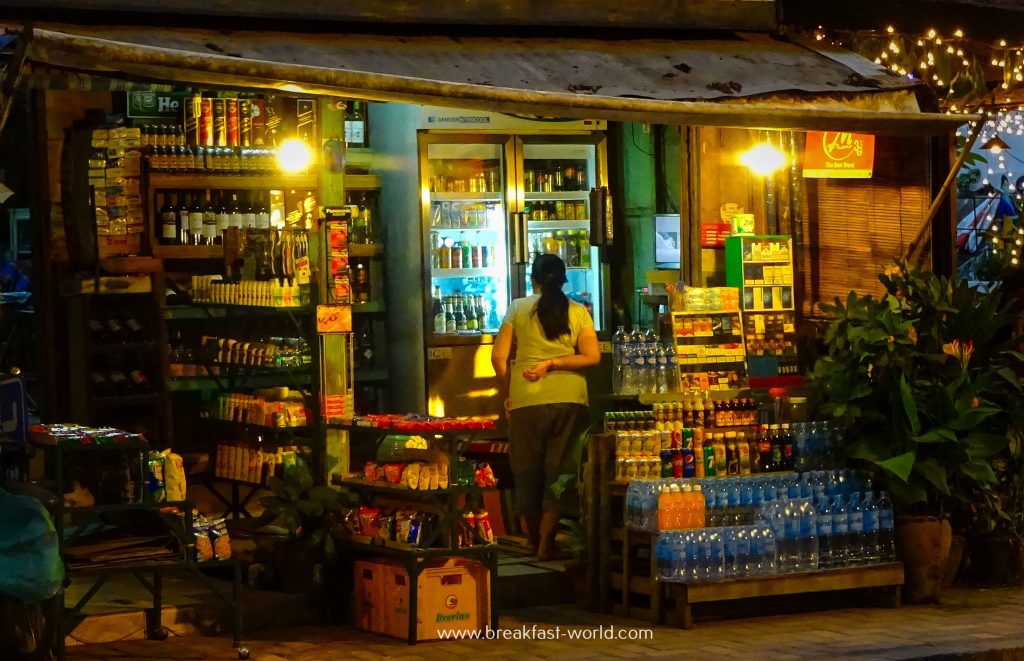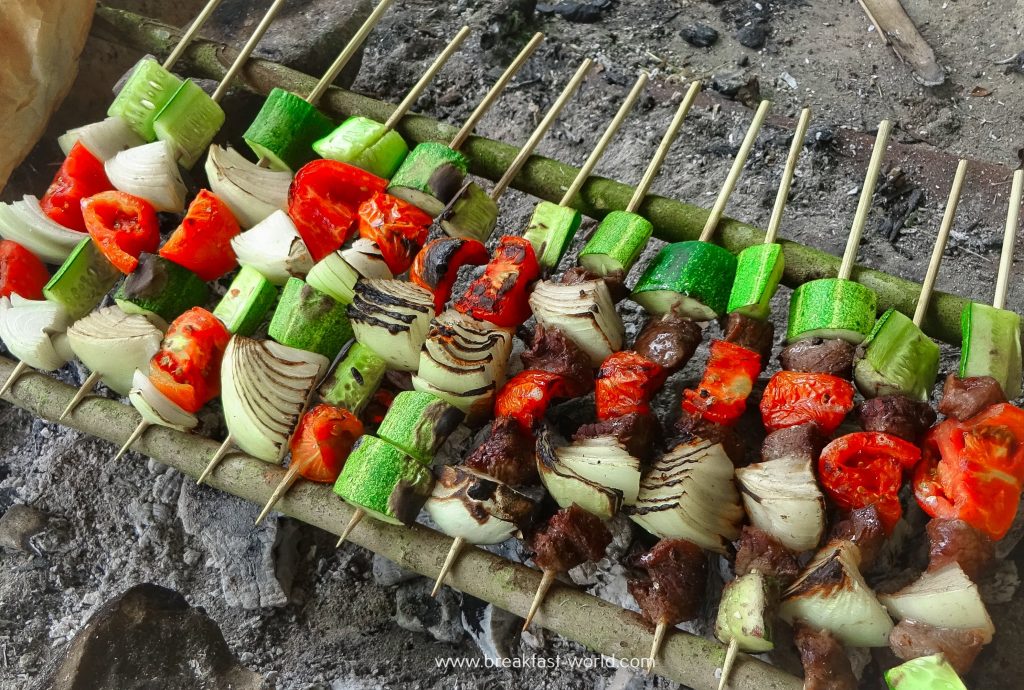Khao Piak Sen (noodle soup) isst man in Laos typischerweise zum Frühstück. Wart Ihr schonmal in Laos? Wenn nicht, dann empfehle ich Euch dringend, dieses kleine Land in Südostasien zu bereisen. Und zwar nicht nur wegen der leckeren Nudelsuppe, sondern insbesondere auch wegen der beeindruckenden Natur, den vielen zauberhaften Tempeln und natürlich auch wegen der herzlichen Menschen.
I could tell a lot more about my trip to Laos, but this is no travel blog but a food blog. Thus, just a few photos:
Jump to Recipe







Laotian cuisine
Laotian cuisine is similar to Thai, Chinese and Vietnamese cuisine. Furthermore, due to its colonial history, it also contains French influences.
Characteristic features of Laotian cuisine
Like all cuisines of Southeast Asia, Laotian cuisine is characterized by the use of many fresh herbs and spices (Thai basil, dill, mint, ginger, coriander, kaffir lime, limes, lemongrass, shallots and garlic).
The Laotians love Chilli (fresh or dried). Therefore, many dishes are pretty spicy. But don't worry: on request, the dishes can of course also be adapted to our taste buds and stomachs.

The main component of Laotian cuisine is Sticky Rice (Khào Niaw). While sticky rice is only served on special occasions in other Southeast Asian countries, in Laos it is part of almost every meal. Sticky rice is not boiled, but steamed. It is traditionally served in a bamboo basket with a lid on a string. At the end of the meal you close the lid to show that you have had enough.
Typical lao food
In addition to rice, a main meal also includes soup, vegetables and meat or fish. Meat, mostly pork, beef, water buffalo or chicken are grilled, fried, processed into sausage or found in soups. Offal are also very popular.

Due to the closeness to the Mekong, people from Laos eat a lot of Fish (grilled or steamed). A special delicacy is Mok Pa (fish steamed in banana leaves).
There are plenty of fresh fruit and vegetables in the markets. vegetables (Cabbage, lettuce, aubergines, carrots, tomatoes, carrots, snake beans, pumpkin, water spinach, etc.) is usually only lightly steamed or raw as a side dish.

Popular snacks, such as dried buffalo skin or chips made from dried river algae take some time getting used to for our taste. This is also true for exotic specialties, that can be found in markets and in some restaurants: roasted grasshoppers, beetles, maggots, caterpillars, scorpions and ant eggs ...
The national dish is Laap, a salad made from minced meat or fish that has a very fresh, hot and sour taste. Fresh herbs, fish sauce, roasted and ground rice grains, lime juice, chilli, shallots, mint and coriander are added to the meat.
Another well-known dish is Green Papaya Salad (Tam Mak Hoong). The main ingredients (green papaya, snake beans, tomatoes, chillies, garlic) are mashed in a large mortar and seasoned with lime juice, fish sauce and shrimp paste. Later on the salad is sprinkled with roasted peanuts.

The Lao breakfast
But now finally for breakfast! The Laotians usually eat Sticky Rice with dried beef, which is seasoned with salt and sugar.
Of course you can get a western breakfast, on every street corner in Laos, as the picture shows:

The French left behind another typical Laotian breakfast: Baguette, that is - similar to the Vietnamese Banh Mi - filled with paté (a kind of liver sausage), lettuce, fresh herbs and hot sauce. It's popular with locals and tourists alike.
In addition, numerous mobile food stalls on the roadside already offer various noodle soups with noodles made from wheat (Mii nam) or rice flour (Föö nam) for breakfast:
Noodle soup - Khao Piak Sen
Meine Lieblingsnudelsuppe, deren Rezept ich Euch gleich verrate, heißt: Khao Piak Sen:

Khao Piak Sen means something like "wet rice noodles": Khao = rice, piak = wet and sen = noodles. Khao Piak Sen is often served for breakfast in Laos. The noodle soup is also suitable for lunch or dinner. In addition, Khao Piak Sen is also often prepared on public holidays such as the Lao New Year celebrations or for family celebrations.
The very special of Khao Piak Sen are the handmade noodles. They are made from rice flour and tapioca starch and they are thicker and chewier than normal rice noodles. Together with the aromatic broth made from chicken, lemongrass, kaffir lime leaves, ginger and soy sauce, the noodles taste just unbelievably good. In any case, I recommend that you make the noodles by yourself. Don't buy the ready-made rice noodles. Don't worry! It's not difficult at all!
You should only keep in mind the following two tips:
- The longer the broth simmers, the better it tastes.
- For the noodle dough you have to mix the flour with boiling water. Boiling water is important for the dough to bind firmly. To avoid burning your fingers, it is best to knead the dough with a food processor.
Now you can get started. Have fun cooking and enjoy your meal!

Khao Piak Sen
Zutaten
For the broth:
- 1,5 l water
- 2 tbsp. granulated chicken stock
- 1 Onion (peeled and halved)
- 2 cloves of garlic (peeled)
- 70 g fresh ginger (cut into thick slices)
- 2 stalks of lemongrass
- 6 Kaffir lime leaves
- 3 tbsp. soja sauce
- 2 tbsp. Fish sauce
- 1 tsp. salt
- 1/2 tsp. sugar
- 1/2 bunch Coriander
- 2 chicken legs (large) with skin
For the Noodles:
- 100 g rice flour
- 100 g tapioca starch
- 1 tsp. Glutinous rice flour
- 200 ml water
For completion:
- 2 small chili peppers
- 1 lime (squeezed)
- fresh coriander
- fresh mint
Anleitungen
For the broth:
- Boil water.
- Add all ingredients to the boiling water and simmer for at least 1.5 hours.
For the Noodles:
- Mix rice flour, tapioca starch and sticky rice flour.
- Boil the water (this is important because of the bond!). Mix the boiling water with the flour and knead with a food processor until the dough is elastic and easy to roll out.

- Dust the work surface with rice flour and tapioca starch in a ratio of 1: 1.
- Halve the dough and shape each into a ball. Cover one half with a moist dish towel to prevent the dough from drying out. Roll out the other half with a rolling pin approx. 1 - 2 mm.
- Cut the dough into narrow strips (approx. 5 mm) with a sharp knife and hang up to dry.

- Do the same for the second half of the dough.
- Let the noodles simmer in boiling water for a few minutes.
For completion:
- Drain the stock through a sieve into a large saucepan.
- Remove the chicken from skin and bones, then pickl the meat into pieces.
- Cut chilli peppers into fine rings (if necessary remove the seeds beforehand).
- Heat the broth. Place the noodles and meat for each person in a soup plate and pour the hot broth over them. Garnish with herbs and chilli to taste. Season to taste with lime juice, fish or soy sauce.
Notizen
It's best to hang them over a clothesline or something similar before cooking. Otherwise the noodle strips might stick together. I helped myself with a broomstick. You can also spice up the soup with vegetables, e.g. fresh bean sprouts, and garnish with fried onions. Since I don't like fried onions, I left them out.
If you like this post, I look forward to a rating (star bar) or a nice comment!
Thanks a lot!
Perhaps you would also like to subscribe to my page. If so you will be regularly informed about new posts.













What a wonderful post, Christina! It brought back so many memories of my time in Laos. I love your photos. Pak Beng and Luang Prabang?
Thank you so much! I am really happy that you like my post. The pictures were taken in Vang Vieng and Luang Prabang.
Sen isn’t a noodle, but a string. Khao piak sen, it literally mean wet rice string.
Thanks Sabaidee for your Feedback. Don’t the noodles look like strings 🙂
It抯 really a nice and helpful piece of info. I am glad that you shared this helpful information with us. Please keep us up to date like this. Thanks for sharing.
It’s a pity you don’t have a donate button! I’d most certainly donate to this excellent blog! I guess for now i’ll settle for bookmarking and adding your RSS feed to my Google account. I look forward to fresh updates and will talk about this blog with my Facebook group. Talk soon!
Fantastic blog! Do you have any helpful hints for aspiring writers? I’m hoping to start my own website soon but I’m a little lost on everything. Would you recommend starting with a free platform like WordPress or go for a paid option? There are so many options out there that I’m completely overwhelmed .. Any recommendations? Bless you!
What抯 Happening i’m new to this, I stumbled upon this I have found It positively helpful and it has aided me out loads. I hope to contribute & assist other users like its helped me. Good job.
Woah! I’m really enjoying the template/theme of this blog.
It’s simple, yet effective. A lot of times it’s difficult to get that „perfect balance“ between user friendliness and visual appeal.
I must say you have done a great job with this. Additionally, the blog loads super quick
for me on Internet explorer. Outstanding Blog!